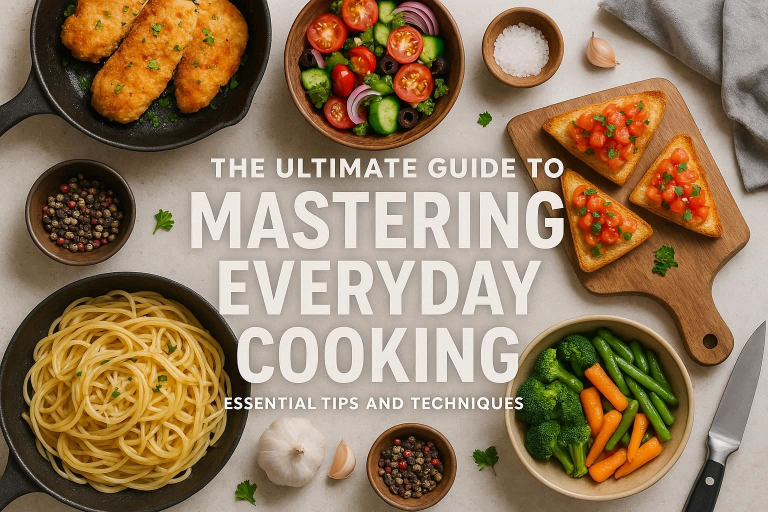Cooking at home isn’t just about preparing meals—it’s an opportunity to bring fresh, healthy, and cost-effective dishes to your table while expressing your creativity. Whether you’re a beginner looking to improve your skills or an experienced cook eager to refine your techniques, mastering everyday cooking is key to making your meals both enjoyable and efficient.
In this ultimate guide, we’ll dive into essential tips and techniques that will transform your cooking routine. From choosing the right tools to mastering fundamental cooking methods, this post is packed with practical advice to help you level up in the kitchen.
Essential Kitchen Tools for Every Cook
Must-Have Tools for Beginners
Every cook needs a set of reliable tools, and investing in the basics can make a huge difference in the kitchen. Here are the essentials:
- Basic Utensils: A sharp chef’s knife, spatulas, tongs, and wooden spoons are foundational. These simple items can be used in nearly every cooking process.
- Cookware Essentials: A few quality pans, pots, baking sheets, and measuring spoons will help you tackle most recipes with ease.
- Kitchen Gadgets: Tools like peelers, graters, timers, and thermometers are incredibly helpful for precision cooking. A thermometer, in particular, is key for ensuring meats are cooked to the right temperature.
These tools might seem simple, but they will allow you to create everything from quick meals to more complex dishes.
Investing in Quality Tools
While basic tools are a great start, the quality of your kitchen equipment matters. A well-sharpened knife can make a world of difference when chopping vegetables or slicing meat. Similarly, investing in a durable non-stick or stainless steel pan can provide better heat distribution and longer-lasting performance.
By choosing quality over quantity, you’ll enjoy better cooking results and a smoother cooking experience.
Basic Cooking Techniques Every Cook Should Master
Knife Skills and Safety
A sharp knife and good technique are essential for safety and efficiency. Start with 50 Time-Saving Recipes for Busy Weeknights learning the basics of how to chop, dice, mince, and julienne ingredients. Knife safety is crucial, so always cut away from your body, use a stable cutting board, and ensure your knife is properly sharpened.
Here’s a tip: Practice your knife skills with onions, garlic, and bell peppers—ingredients used in almost every dish!
Sautéing and Stir-Frying
These quick and effective cooking methods are perfect for creating rich, flavorful meals. To sauté, heat oil or butter in a pan and cook your ingredients over medium-high heat until they’re golden and tender.
For stir-frying, use high heat and a wok or large skillet. Toss your ingredients quickly in the hot oil to preserve flavor and texture. Stir-frying is ideal for vegetables, meats, and tofu, and it’s done in just a few minutes.
Roasting and Baking
Roasting intensifies the natural flavors of vegetables, meats, and fish. Preheat your oven to the desired temperature and cook your ingredients until they’re browned and crispy. It’s a hands-off technique that enhances flavors, especially for root vegetables like carrots, potatoes, and sweet potatoes.
Baking, on the other hand, is perfect for pastries, breads, and casseroles. Understanding oven temperatures, ingredient ratios, and baking times will help you create dishes that are perfectly cooked every time.
Boiling, Steaming, and Blanching
These techniques are essential for preparing basic sides like pasta, rice, and vegetables. To boil, bring water to a rolling boil and cook your ingredients until tender. Steaming, which preserves nutrients, is done by cooking food over boiling water. Blanching briefly immerses vegetables in boiling water before transferring them to an ice bath to stop the cooking process—this is great for preserving color and texture.
Understanding the Art of Seasoning
Balancing Salt, Sweet, Sour, and Umami
A dish’s flavor profile can be enhanced by balancing basic seasonings like salt, pepper, and herbs. Salt brings out the natural flavors of ingredients, while sugar adds sweetness, acidity balances out richness, and umami (found in soy sauce, tomatoes, or cheese) adds depth to your dishes.
Start by tasting your dish as you cook, adjusting the seasonings little by little until it feels just right.
Using Fresh Herbs vs. Dried Herbs
Fresh herbs like basil, parsley, and cilantro are vibrant and aromatic but can be pricier and less shelf-stable than dried herbs like oregano or thyme. In recipes that call for long cooking times, dried herbs release their flavors more effectively, while fresh herbs shine when added at the end of cooking for a fresh burst of flavor.
A good tip: Keep your fresh herbs in the fridge wrapped in a damp paper towel, or freeze them in ice cube trays for longer storage.
Spice Mastery: How to Use Spices for Maximum Flavor
Spices such as cumin, cinnamon, and paprika can instantly elevate your dishes. Begin experimenting with common spice blends like curry powder or garam masala, which take the guesswork out of combining spices. Start small and build up the complexity of your flavors as you get comfortable.
Meal Planning and Prep Strategies for Busy Cooks
How to Plan Your Weekly Meals
Meal planning isn’t just about saving time—it’s about saving money and reducing stress. Start by organizing meals based on what you already have at home, planning balanced meals that are easy to prepare, and creating a grocery list to minimize food waste.
For example, consider planning meals that use overlapping ingredients, like a batch of roasted chicken that can be repurposed into salads, wraps, or stir-fries throughout the week.
Meal Prep Techniques to Save Time
Batch cooking allows you to prepare large portions of food at once, saving time during the week. Cook your grains, proteins, and vegetables in bulk and store them in individual portions for easy access.
Consider making soups, stews, or casseroles in advance—these meals often taste even better after a day or two in the fridge.
How to Stock Your Pantry and Fridge
A well-stocked pantry will be your best friend on busy weeknights. Keep essential items like grains, beans, canned tomatoes, spices, and oils within easy reach. In your fridge, always have fresh vegetables, eggs, dairy products, and leftovers ready to go.
Organizing your pantry and fridge will help you quickly find what you need, ensuring you can whip up a meal in no time.
Cooking for Different Diets and Preferences
Cooking for a Vegan or Vegetarian Diet
If you’re cooking plant-based meals, focus on incorporating proteins like beans, tofu, tempeh, and lentils. Nutritional yeast is a great addition for adding a cheesy flavor without the dairy. Keep a variety of fresh vegetables, grains, and legumes stocked up for versatile meal options.
Gluten-Free Cooking Made Easy
Gluten-free cooking requires a few simple swaps. Rice flour, almond flour, and quinoa are great substitutes for wheat-based products. For gluten-free pasta, try options made from rice, corn, or legumes. It’s easy to adapt favorite recipes for gluten-free diets with just a few ingredient adjustments.
Low-Carb Cooking Tips
For low-carb meals, explore alternatives like cauliflower rice or zucchini noodles. These ingredients not only reduce carbs but also add variety to your dishes. Create low-carb salads, stir-fries, and casseroles without sacrificing flavor.
Creating Flavorful One-Pot Meals
The Magic of One-Pot Dishes
One-pot meals are the ultimate time-savers. They require minimal prep, one pot for cooking, and fewer ingredients. Think soups, stews, risottos, and casseroles—these meals can be packed with flavor and made in no time.
Start with a basic base like onions, garlic, and broth, then add your protein and vegetables for a complete meal.
Slow Cooker and Instant Pot Recipes
A slow cooker or Instant Pot can be a game-changer when you’re pressed for time. With a slow cooker, you can prepare a hearty beef stew, chili, or pulled pork while you’re away. Instant pots, on the other hand, reduce cooking time for dishes like risotto or braised meats by a fraction of the time.
Time-Saving Cooking Hacks
How to Speed Up Your Cooking Without Sacrificing Flavor
Use pre-chopped vegetables, frozen ingredients, and store-bought bases (like pre-made sauces or broths) to save time without compromising on taste.
Multitask by prepping ingredients while other components of your meal are cooking. For example, while your chicken roasts in the oven, prepare a side salad or a simple dessert.
10-Minute Meals for Busy Days
Sometimes, you need a meal in 10 minutes or less. Think about simple dishes like scrambled eggs with spinach, a quick stir-fry, or a hearty salad with protein (like grilled chicken or canned beans).
Using pantry staples like canned tomatoes, tuna, and pasta will help you throw together a meal in no time.
How to Keep Leftovers Fresh
Leftovers are a lifesaver, but proper storage is key. Store leftovers in airtight containers to preserve flavor and texture. When reheating, avoid overcooking—microwaving on a lower heat or using a stovetop to gently warm food can help maintain its quality.
Cooking Tips from Professional Chefs
Pro Tips for Better Knife Skills
Chef’s tip: Use a sharp, high-quality knife to make cutting faster and safer. Hold the knife with a firm grip and use a rocking motion for efficient chopping.
How to Avoid Common Cooking Mistakes
Common cooking mistakes include overcooking food, not seasoning properly, or not following recipes to the letter. Understanding the role of heat control and the timing of adding ingredients can help avoid these pitfalls.
FAQ
How can I improve my cooking skills quickly?
Practice basic techniques like chopping, seasoning, and using heat effectively. Watch cooking tutorials and gradually take on more complex dishes.
What is the most important cooking technique to master first?
Knife skills are crucial. Start with learning proper chopping and slicing techniques, followed by mastering sautéing and roasting.
How can I plan meals when I have little time to cook?
Meal prep and one-pot recipes can save time. Make use of ingredients that can be prepared in bulk and stored for later.
How can I cook for special diets without feeling overwhelmed?
Start simple by substituting ingredients gradually and focus on versatile cooking methods like stir-frying and roasting.
Can I cook healthy meals without spending a lot of time in the kitchen?
Yes, use batch cooking, a slow cooker, or an Instant Pot for easy, healthy meals with minimal effort.
Conclusion
Mastering everyday cooking is an essential skill that will make your life easier, healthier, and more fulfilling. Whether you’re a beginner or an experienced cook, applying these techniques and tips will help you make the most of your time in the kitchen.
Start experimenting today and bring creativity to your meals, transforming your cooking routine into a fun and satisfying experience!

